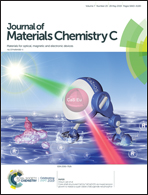Enhancing thermoelectric properties by using a surface polarization effect based on PEDOT:PSS thin films†
Abstract
Poly(3,4-ethylenedioxythiophene):polystyrene sulfonate (PEDOT:PSS) as a semi-metal material is a promising thermoelectric material with polaron-type transport properties. PEDOT:PSS possesses a large density of polaron energy levels within the bandgap. In this article, we report a large power factor (PF) of 96 μW mK−2 by combining semi-metal PEDOT:PSS with metal layers with a vertical sandwiched device configuration (metal/PEDOT:PSS/metal) under relatively high temperature conditions. The capacitance–voltage and atomic force microscopy (AFM) studies suggest that the polarons largely contribute to surface polarization in a metal/PEDOT:PSS/metal device due to electron–phonon coupling. The electrode and temperature dependent capacitance mainly originates from the surface polarization effect, in which the surface polarization functions as an additional driving force to diffuse the charge carriers from a hot to a cold surface. Essentially, the surface polarization generates a high Seebeck effect with a high electrical conductivity, resulting in a large PF. Finally, we have successfully determined the thermal current density in the Au(hot)/PEDOT:PSS/Au(cold) device, which confirms that the surface polarization can indeed function as an additional driving force to enhance the Seebeck effect through a metal/semi-metal interface device structure.



 Please wait while we load your content...
Please wait while we load your content...